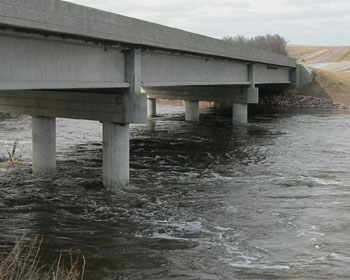MPC Research Reports
Report Details
Abstract
 The South Dakota Department of Transportation (SDDOT) currently has a Finite-Element Surface-Water Modeling System for Two-Dimensional Flow (FESWMS-2DH) and Research Management Associates 2 (RMA2) Both programs have the capability to model two-dimensional (2D) flow around structures. The department must identify settings in which a 2D model would be beneficial, and to determine what degree of effort needs to be invested in data collection to produce an effective model. Once these factors are understood, site-specific 2D models can be utilized to properly analyze structures subject to compound channel flow and to design the structure to minimize damage caused by scour. The research began with a literature review and a survey of current practices used by other state DOTs. The SD 13 Bridge over the Big Sioux River near Flandreau and the SD 37 bridges over the James River near Mitchell were selected to conduct a 2D flow analysis. Two-dimensional flow models were created for each bridge site and validated using field measurements. A sensitivity analysis was conducted to determine the critical input parameters to develop an effective model. Modeling results were used to investigate the site conditions producing 2D flow effects and to predict pier and contraction scour. This report recommends that SDDOT does the following: (1) develops a formal decision-making process for selecting hydraulic models, (2) coordinates with other agencies to collect LiDAR data in South Dakota, (3) conducts a department needs assessment to establish a continuing education program for SDDOT engineers, (4) conducts additional case studies to develop improved design guidelines, (5) measures soil erodibility when evaluating scour at bridges, (6) initiates a research project to collect flow and scour data at selected bridge sites during high flow events, and (7) supports research to develop long-term hydrograph for use in scour predictions in cohesive soils.
The South Dakota Department of Transportation (SDDOT) currently has a Finite-Element Surface-Water Modeling System for Two-Dimensional Flow (FESWMS-2DH) and Research Management Associates 2 (RMA2) Both programs have the capability to model two-dimensional (2D) flow around structures. The department must identify settings in which a 2D model would be beneficial, and to determine what degree of effort needs to be invested in data collection to produce an effective model. Once these factors are understood, site-specific 2D models can be utilized to properly analyze structures subject to compound channel flow and to design the structure to minimize damage caused by scour. The research began with a literature review and a survey of current practices used by other state DOTs. The SD 13 Bridge over the Big Sioux River near Flandreau and the SD 37 bridges over the James River near Mitchell were selected to conduct a 2D flow analysis. Two-dimensional flow models were created for each bridge site and validated using field measurements. A sensitivity analysis was conducted to determine the critical input parameters to develop an effective model. Modeling results were used to investigate the site conditions producing 2D flow effects and to predict pier and contraction scour. This report recommends that SDDOT does the following: (1) develops a formal decision-making process for selecting hydraulic models, (2) coordinates with other agencies to collect LiDAR data in South Dakota, (3) conducts a department needs assessment to establish a continuing education program for SDDOT engineers, (4) conducts additional case studies to develop improved design guidelines, (5) measures soil erodibility when evaluating scour at bridges, (6) initiates a research project to collect flow and scour data at selected bridge sites during high flow events, and (7) supports research to develop long-term hydrograph for use in scour predictions in cohesive soils.
How to Cite
Ting, Francis C. K., Ryan J. Larsen, and Ryan P. Rossell. Analysis of Compound Channel Flow with Two-Dimensional Models, MPC-17-336. North Dakota State University - Upper Great Plains Transportation Institute, Fargo: Mountain-Plains Consortium, 2017.

